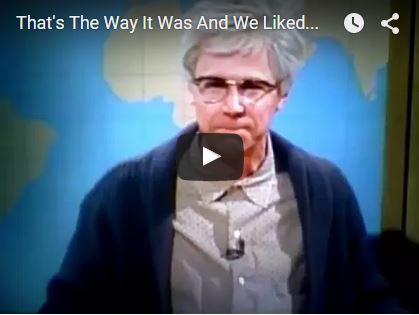In my day, we didn’t have peewee soccer, football, gymnastics, or tee-ball. We had to improvise and make up game rules to play two-on-two football. We had no gear; not even the cheap plastic crap from Sears. We set the lawn mower as low as it would go to cut the sidelines and goal lines and made up the rules as we went. We were a bunch of hayseeds throwing a rubber football around, inflicting bone-on-bone pain to each other, pretending to be in the NFL – and we liked it!
This may sound like the Grumpy Old Man, but it is 100% accurate and true.
In our childhood lala land, we created things and made rules that made sense to us for the situation. We all agreed and played on. If we wanted to change the rules in an instant, we did. So what?
In energy efficiency, ironically we come across grumpy old men who behave like children in their youth – they like to make up their own rules as they go, rather than follow the rules and laws in place. I guess this makes sense because as they say, you go out like you came in – totally dependent on responsible, reliable adults. But when energy efficiency coots get to this stage, I think it’s time to step down.
Years ago, as we were determining energy impacts relative to the current energy code for new construction, we encountered one such coot. As described a couple weeks ago in the post From Russia with Love, Walmart has long been an implementer and one could say, one of the leaders in box-store energy efficiency. We estimated savings for their new stores and determined rebates for those facilities built in the utility’s service territory.
For this program, savings were later evaluated by an independent third-party engineer – call him the grumpy old Walmart coot. When grumpy old Walmart coot analyzed these Walmart projects, his conclusion for several measures, and in particular lighting and daylighting controls, was, to paraphrase, “no savings for you”. The reason: Walmart does that for all their stores. Well gee wiz, maybe they do that for all their stores because most utilities offer attractive incentives for these features. It isn’t your job to inject your opinion into the matter.
Our response: You can’t do that. Your job, and our jobs as evaluators and M&V specialists, isn’t to make rules as we go. Who appointed you God and distributor of good and evil?
If we don’t follow the rules and laws, chaos prevails. Fortunately for utility programs, the rules are quite straight forward. Unfortunately for many utilities, the rules, particularly for custom efficiency, are not well documented. Certainly, one rule that should not need to be written down is, Walmart (or anyone else) is subject to different rules and baselines compared to everyone else.
In another case, a grumpy old coot was/is far out of bounds; so far out of bounds he completely failed his project’s mission, in my view. He likely continues to fail his projects’ missions. His mission is to evaluate programs, and this includes impact (savings) and program cost effectiveness.
As I listened to him rant about cost effectiveness methods at a recent industry forum, he wants to inject his beliefs and opinions into the evaluation to the point where he loses sight of the evaluation’s mission. For example, he wants to inject all kinds of external benefits (externalities) of energy efficiency – like energy efficiency helps avoid the construction of transmission lines, which emit electromagnetic waves (making this up on the fly) that make dogs bark 30% more, and this reduces sleep time by 8% for the average customer. This would translate to an additional 1.4 cents per kWh saved. This should be included in the benefit/cost analysis! Energy efficiency reduces particulate emissions, which leads to lower asthma impacts of children – etc. etc. – things egg heads proclaim to accurately measure.
Dude, that is not your job. Do you want to be an evaluator or an activist/lobbyist? You can’t be both.
Judging from the results of this grumpy old externality coot’s evaluations, energy efficiency programs are as pure as the snowflakes falling from the sky. Everybody gets an A. The impacts are 100% legit. Free ridership is zero. Realization rates[1] are 100%. Why? Because he is a cheerleader for energy efficiency and an activist for an agenda. Don’t let the messy underbelly of the programs get in the way of anything.
[1] Realization rate equals evaluator-verified savings divided by program-implementer-estimated savings.

